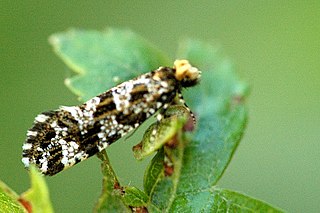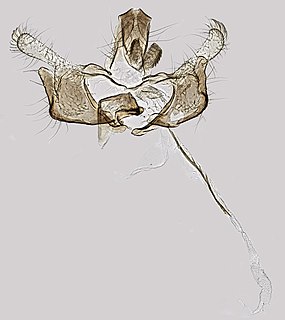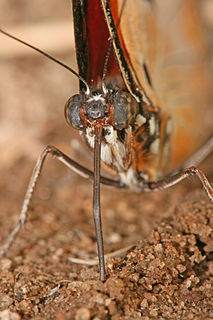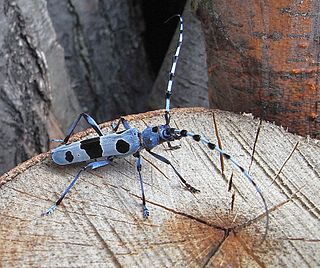
The Blastobasidae are a family of moths in the superfamily Gelechioidea. Its species can be found almost anywhere in the world, though in some places they are not native but introduced by humans. In some arrangements, these moths are included in the case-bearer family (Coleophoridae) as subfamily Blastobasinae. The Symmocidae are sometimes included in the Blastobasidae as subfamily or tribe.
Pityocona is a small and little-known genus of the twirler moth family (Gelechiidae). Among these, it is believed to belong to subfamily Gelechiinae, but beyond that its relationships are still obscure.

Monopis obviella is a species of tineoid moth. It belongs to the fungus moth family (Tineidae), and therein to the nominate subfamily Tineinae. It is the type species of Blabophanes, today treated as a junior synonym of the genus Monopis. M. crocicapitella was only separated from the present species in 1859, and is still frequently confused with it even by rather recent sources.

Triaxomera parasitella is a species of tineoid moth. It belongs to the fungus moth family (Tineidae), and therein to the subfamily Nemapogoninae. It is widespread and common in much of western Eurasia, but seems to be absent from some more outlying regions, such as Portugal and the eastern Baltic, Ireland and Iceland. It has also not been recorded from Slovenia but given that it is found in neighboring countries, it may well occur there unnoticed. Recently, the species was recorded from British Columbia. Generally, it is a moth of warm temperate regions, e.g. in Great Britain it is only a rare and scarce species from the English Midlands northwards.

Tinea pellionella, the case-bearing clothes moth, is a species of tineoid moth in the family Tineidae, the fungus moths. It is the type species of the genus Tinea, which in turn is the type genus of the subfamily, family, as well as the superfamily Tineoidea. Its scientific name is derived from "tinea", a generic term for micromoths, and the Latin term for a furrier, pellionellus.
Surattha is a genus of moths of the family Crambidae. The genus was synonymized with Prionapteryx by Stanisław Błeszyński in 1967. Its status was later revised by Graziano Bassi and Wolfram Mey in 2011.
Scirpophaga is a genus of moths of the family Crambidae described by Georg Friedrich Treitschke in 1832.
Tessema sensilis is a little-known moth species, the only member of genus Tessema. It belongs to the grass moth family (Crambidae), and therein to the large subfamily Spilomelinae; at the time of its description, these were still included in subfamily Pyraustinae and the entire Crambidae was then merged with the snout moths. While its detailed relationships are undetermined, it may be a close relative of Herpetogramma and/or Pilocrocis.
Clarkeophlebia is an enigmatic and almost-unknown gelechioid moth genus. It contains a single species, Clarkeophlebia argentea, and is apparently endemic to Fatu Hiva in the Marquesas Islands of Polynesia. It was originally described as Acanthophlebia, but this name had earlier been given to a genus of prong-gilled mayflies.
Asymphorodes is a gelechioid moth genus in subfamily Agonoxeninae of the palm moth family (Agonoxenidae), whose taxonomic status is disputed. Alternatively, the palm moths might be a subfamily of the grass-miner moth family (Elachistidae), with the Agonoxeninae becoming a tribe Agonoxenini.
Herlinda is a genus of cosmet moths. These moths were only discovered in 1968 and the genus was not described until 1986; its affiliations within the family are presently unknown. This genus, as far as is known, is endemic to the Marquesas Islands of Polynesia, with each species confined to a single island.

Erechthias is a genus of the fungus moth family, Tineidae. Therein, it belongs to the subfamily Erechthiinae, of which it is the type genus. The exact circumscription of this genus is still disputed, but it may encompass more than 150 species.

The skin moth is a species of tineoid moth. It belongs to the fungus moth family (Tineidae), and therein to the nominate subfamily Tineinae. It is the type species of the genus Monopis and its junior objective synonym Hyalospila. As with the common clothes moth, earlier authors frequently misapplied the name Tinea vestianella to the present species.

Coleophora betulella is a moth of the family Coleophoridae. It is found in all of Europe, except the Balkan peninsula.
Phereoeca allutella, the household case-bearing moth, belongs to the subfamily Tineinae of the fungus moth family (Tineidae). It was first described by Hans Rebel in 1892. It is an occasional pest of furs, flannel and similar materials, and has been inadvertently introduced to many places it is not originally native to.

Erechthias simulans is a species of fungus moth. It is here considered to belong to the somewhat controversial type genus of its subfamily Erechthiinae, though even fairly recently some authors have proposed to retain other genera such as Decadarchis separate from Erechthias. Decadarchis, with E. simulans as type species, would in fact contain this moth and its closest relatives, regardless whether it is recognized as full genus or as subgenus. These relatives are generally held to be a group of mainly Polynesian species. E. simulans has also been mistaken for a species of the closely related genus Comodica; while the delimitation of this versus Erechthias/Decadarchis is not universally agreed upon, E. simulans is not included in Comodica anymore by modern authors.

The Phycitinae are a subfamily of snout moths. Even though the Pyralidae subfamilies are all quite diverse, Phycitinae stand out even by standards of their family: with over 600 genera considered valid and more than 4000 species placed here at present, they unite up more than three-quarters of living snout moth diversity. Together with the closely related Epipaschiinae, they are apparently the most advanced lineage of snout moths.

Autosticha is a genus of gelechioid moths. It belongs to the subfamily Autostichinae, which is either placed in the concealer moth family (Oecophoridae), or in an expanded Autostichidae. It is the type genus of its subfamily. Originally, this genus was named Automola, but this name properly refers to a fly genus in family Richardiidae.

Tinea belonota is a species of moth in the family Tineidae. It is endemic to New Zealand. It is classified as not threatened by the Department of Conservation.













